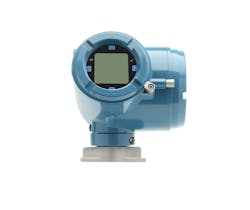Coriolis flow transmitter with Bluetooth option improves productivity, safety and reliability
Coriolis mass flowmeter sensor and transmitter assemblies are often used in chemical, pharmaceutical and other industrial applications requiring mass flow readings with a high degree of accuracy and reliability. In addition to the primary mass flow reading, they can also provide secondary density and temperature measurements to host systems via various types of digital links, along with locally stored calibration and diagnostic data. Typical hosts may include a distributed control system (DCS), an asset management system (AMS), a laboratory information management system (LIMS) and others.
Measurements from Coriolis flowmeter transmitters can be used to ensure precise accounting for mass balance within a plant, optimize the efficiency of a process to minimize waste or over-dosing, monitor or improve overall system performance, and many other applications.
A DCS typically uses the mass flow reading from the transmitter to perform real-time control, while an AMS or LIMS receives and stores historical measurement values, and tracks totalization amounts, calibration and diagnostic information. Plant personnel use this information to reduce downtime, cut maintenance costs, improve safety and make other operational decisions and improvements.
These types of flowmeter assemblies are ideally suited for process plants facing the challenge of meeting environmental, social and governance targets because they support efforts for reducing energy intensity, minimizing emissions and improving safety. Data from Coriolis mass flowmeter transmitters is vital for providing these and other benefits, but there may be challenges with adapting older mass flow meters to achieve these goals in some existing applications.
Issues with existing transmitters
Coriolis flowmeter assemblies have been used extensively throughout the process industries for decades, with many units still in operation after many years of service. While flowmeter sensor units have improved over the years, many older designs still provide the required level of performance and reliability.
Because these flowmeter assemblies have proven their reliability for years, or even decades in some cases, end users prefer not to rip and replace them. This is particularly true for flowmeter sensors, which are installed within the piping, making replacement often a difficult and expensive proposition. On the other hand, transmitters can often be replaced quite easily, overcoming challenges with existing units.
Older transmitters often have outdated local operator interfaces that perform as originally designed, but without the latest features. For example, older transmitters may use a two-button interface, which can make operation interactions difficult and time-consuming. Many of these interfaces do not have a backlit display, which makes configuring the device at night quite cumbersome.
In addition to local operator interface issues, connecting to older transmitters can be difficult, often requiring the use of legacy physical connections, such as RS-485. Older transmitters typically don not provide smart diagnostic tools, making troubleshooting rigorous and burdening plant personnel.
Fortunately, all these and other issues can be addressed by updating the transmitter on existing Coriolis flowmeter assemblies, while preserving investments in flowmeter sensors.
Retrofit solution provides modern capabilities
End users have deployed Micro Motion Coriolis flowmeters extensively in a variety of industries, including chemical, food and beverage, life sciences, oil and gas, petrochemical and others. Many of these end users are interested in switching to an upgraded transmitter with additional features and benefits, while avoiding the expense of changing existing flowmeter sensor installations, which typically have provided decades of trouble-free measurement service.
The Micro Motion 4700 Coriolis Transmitter addresses this issue with a retrofit solution designed to replace the legacy transmitter in existing installations for integral mount 1700/2700 transmitters. Once installed, the transmitter will automatically interface with the existing flowmeter, adding capabilities just as if it were a new application The transmitter is compatible for new installations with all Micro Motion ELITE (CMF and CMFS), F-Series, G-Series, H-Series, R-Series, T-Series and HPC-Series Coriolis flowmeters (Figure 2).
The 4700 transmitter offers improvement over legacy electronics. The local operator interface is fully configurable from the display, and it is fully backlit to provide clear visibility, even at night or with poor ambient light. This display is controlled using four capacitive touch buttons, making user navigation much quicker and simpler than with older two-button models.
Connecting to the 4700 is easier than ever before. For remote connectivity to a host, such as a distributed control or asset management system, the 4700 is provided with multiple configurable wired I/O channels. Channel A includes 4-20mA HART for two-way communications, a frequency output and a discrete output. Channel B includes a 4-20mA, frequency, and discrete output, and a discrete input. Channel C provides two-way digital communication via Modbus RS-485.
To connect locally to the device, the transmitter has a USB A port. Through this port, users can configure, characterize and diagnose device systems with simplicity.
The device also supports wireless connectivity via a Bluetooth option, which provides secure two-way wireless configuration communications at distances up to 15 meters between the transmitter and any device capable of hosting a web browser, such as a laptop, smartphone or tablet. Wireless access via Bluetooth allows users to configure the meter, view a wide range of internal diagnostics and access other information, all from afar. Many other Emerson instruments are available with Bluetooth connectivity, providing end users with a consistent interface experience across a wide range of products.
Using the AMS Device Configurator application, users can quickly locate and identify transmitters, and then perform tasks related to configuration, device status and diagnostics. Reliability is improved because transmitters no longer need to be opened for access, protecting them from exposure to the environment.
This wireless connectivity does not require a hot work permit in most cases because the transmitter does not need to be opened for connection, which is particularly important in areas that are difficult to reach. Depending on the distances involved, users can also connect to the transmitter from outside of a hazardous area, improving safety.
The transmitter is supplied with Smart Meter Verification Basic and Zero Verification as standard, with Smart Meter Verification Professional available as a licensable option for accessing and printing reports. Advanced Phase Measurement, capable of detecting multiphase conditions where the process fluid contains entrained gas, is also available as an option to correct the mass and flow volume measurements under these conditions.
A built-in data historian is also available as an option for storing up to 13.5 days of data at a one-second scan rate, and simultaneously up to one year of data at a five-minute scan rate. This option provides a complete audit trail and alert log, with time-stamped Smart Meter Verification reports.
As with most Micro Motion Coriolis transmitters, the Micro Motion 4700 is equipped with multiple configurable wired I/O channels for communication with hosts, such as a DCS or AMS (Figure 3). Channel A includes the following licensable options: 4-20mA HART for two-way communications, a frequency output and a discrete output. Channel B includes the following licensable options: a 4-20mA, frequency, and discrete output, and a discrete input. Channel C includes one licensable option: two-way digital communication via Modbus RS-485.
The transmitter housing is aluminum, providing a degree of corrosion resistance, and it is rated for Zone 1 installation. It carries a SIL 2 rating as a single device, and it is SIL 3 capable when multiple meters are installed. All meters are certified per IEC 61508. The SIL license enables a comparison diagnostic between the programmed mA current output and the internal readback value to alert users or a safety system of potential electronics trouble so corrective action can be performed.
Real-world results
Chemical plant personnel often have a need to access mass flowmeters and perform tasks such as configuration, calibration or troubleshooting. In the past, this has required physical access to the meter, and in some cases removing the meter’s housing, making temporary connections, performing tests and reinstalling the housing. This presents a number of problems, such as:
- Difficult to access the meter due to its location.
- Need to enter a hazardous area.
- Required hot work permit.
- Worker exposure to potential hazards.
The 4700 transmitter addresses these and other issues by providing wireless access via Bluetooth at distances up to 50 feet. This allows plant personnel to remotely access meters and perform the most commonly required tasks, without having to touch the meter itself.
Oil and gas, and many other heavy industries, often have flowmeters installed outdoors in harsh environments, making sensor replacement quite cumbersome as it often requires the use of heavy installation machinery. This is typically a complicated and costly task, and it requires a process interruption and downtime. To address this type of issue, the existing sensor can be left in place, with the existing transmitter replaced with the 4700. The entire retrofit takes approximately 15 minutes, versus a day or more for replacement of the sensor and transmitter.
Conclusion
The Micro Motion 4700 Transmitter provides an ideal solution for upgrades to existing Micro Motion Coriolis installations, and it is available as an option to provide advanced capabilities for new sensor and transmitter assembly purchases.
Brett Sibel is a Coriolis electronics and software product manager at Emerson. Prior to joining the company, he worked as a product engineer and product manager in various industries, including electronics, biomedical design and automation solutions. Sibel holds a Mechanical Engineering degree from the University of Colorado at Boulder, and he is currently pursuing a Master of Business Administration degree from the University of Colorado at Denver.
About the Author
Brett Sibel
Product Manager at Emerson
Brett Sibel is a Coriolis electronics and software product manager at Emerson. Prior to joining the company, he worked as a product engineer and product manager in various industries, including electronics, biomedical design, and automation solutions. Sibel holds a Mechanical Engineering degree from the University of Colorado at Boulder, and he is currently pursuing a Master of Business Administration degree from the University of Colorado at Denver.


